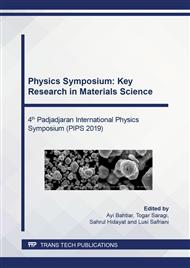[1]
S. Singh, S. Jain, P.S. Venkateswaran, A.K. Tiwari, M.R. Nouni, J.K. Pandey, S. Goel, Hydrogen: A sustainable fuel for future of the transport sector, Renew. Sustain. Energy Rev. 51 (2015) 623–633.
DOI: 10.1016/j.rser.2015.06.040
Google Scholar
[2]
K. Hassmann, H.M. Kühne, Primary energy sources for hydrogen production, Int. J. Hydrogen Energy 18 (1993) 635–640.
DOI: 10.1016/0360-3199(93)90115-q
Google Scholar
[3]
A.S. Arico, P. Bruce, B. Scrosati, J.-M. Tarascon, W. van Schalkwijk, Nanostructure materials for advanced energy conversion and storage devices, Nat. Mater. 4 (2005) 366–377.
DOI: 10.1038/nmat1368
Google Scholar
[4]
X. Du, C. Wang, M. Chen, Y. Jiao, J. Wang, Electrochemical performances of nanoparticle Fe3O4/activated carbon supercapacitor using KOH electrolyte solution, J. Phys. Chem. C 113 (2009) 2643–2646.
DOI: 10.1021/jp8088269
Google Scholar
[5]
M. Inagaki, H. Konno, O. Tanaike, Carbon materials for electrochemical capacitors, J. Power Sources 195 (2010) 7880–7903.
DOI: 10.1016/j.jpowsour.2010.06.036
Google Scholar
[6]
A.G. Pandolfo, A.F. Hollenkamp, Review: Carbon properties and their role in supercapacitors, J. Power Sources 157 (2006) 11–27.
DOI: 10.1016/j.jpowsour.2006.02.065
Google Scholar
[7]
P. Simon, Y. Gogotsi, Materials for electrochemical capacitors, Nat. Mater. 7 (2008) 845–854.
Google Scholar
[8]
W.T. Gu, G. Yushin, Review of nanostructured carbon materials for electrochemical capacitor applications: advantages and limitations of activated carbon, carbide-derived carbon, zeolite-templated carbon, carbon aerogels, carbon nanotubes, onion-like carbon and graphene, WIREs Energy Environ. 3 (2014) 424–473.
DOI: 10.1002/wene.102
Google Scholar
[9]
Y.P. Zhai, Y.Q. Dou, D.Y. Zhao, P.F. Fulvio, R.T. Mayes, S. Dai, Carbon materials for chemical capacitive energy storage, Adv. Mater. 23 (2011) 4828–4850.
DOI: 10.1002/adma.201100984
Google Scholar
[10]
L.L. Zhang, X.S. Zhao, Carbon-based materials as supercapacitor electrodes, Chem. Soc. Rev. 38 (2009) 2520–2531.
Google Scholar
[11]
D.P. Dubal, J.G. Kim, Y. Kim, R. Holze, C.D. Lokhande, W.B. Kim, Supercapacitors based on flexible substrates: An Overview, Energy Technol. 2 (2014) 325–341.
DOI: 10.1002/ente.201300144
Google Scholar
[12]
M. Winter, R.J. Brodd, What are batteries, fuel cells and supercapacitors?, Chem. Rev. 104 (2004) 4245–4270.
DOI: 10.1021/cr020730k
Google Scholar
[13]
J.R. Miller, P. Simon, Electrochemical capacitors for energy management, Science 321 (2008) 651–652.
Google Scholar
[14]
C.-C. Hu, K.-H. Chang, M.-C. Lin and Y.-T. Wu, Design and tailoring of the nanotubular arrayed architecture of hydrous RuO2 for next generation supercapacitors, Nano Lett. 6 (2006) 2690–2695.
DOI: 10.1021/nl061576a
Google Scholar
[15]
R. Vellacheri, A. Al-Haddad, H. Zhao, W. Wang, C. Wang, Y. Lei, High performance supercapacitor for efficiency energy storage under extreme environmental temperatures, Nano Energy 8 (2014) 231–237.
DOI: 10.1016/j.nanoen.2014.06.015
Google Scholar
[16]
P. B. Karandikar, A. Negi, A. Kumar Pandey, S. Kumar, Comparative study of rolled and stacked type aqueous Supercapacitor, IEEE Global Humanitarian Technology Conference: South Asia Satellite (GHTC-SAS) (2013) 260–263.
DOI: 10.1109/ghtc-sas.2013.6629927
Google Scholar
[17]
P. Cao, Y. Fan, J. Yu, R. Wang, P. Song, Y. Xiong, Polypyrrole nanocomposites doped with functional ionic liquids for high performance supercapacitors, New J. Chem. 42 (2018) 3909–3916.
DOI: 10.1039/c7nj04367h
Google Scholar
[18]
L. Zhang, K. Tsay, C. Bock, J. Zhang, Ionic liquids as electrolytes for non-aqueous solutions electrochemical supercapacitors in a temperature range of 20oC - 80oC, J. Power Sources 324 (2016) 615–624.
DOI: 10.1016/j.jpowsour.2016.05.008
Google Scholar
[19]
Z. Hou, H. Lu, Q. Yang, Q. Zhao, J. Liu, Micromorphology-controlled synthesis of polypyrrole films by using binary surfactant of Span80/OP10 via interfacial polymerization and their enhanced electrochemical capacitance, Electrochem. Acta 265 (2018) 601–608.
DOI: 10.1016/j.electacta.2018.01.164
Google Scholar
[20]
L. Hou, Y. Shi, C. Wu, Y. Zhang, Y. Ma, X. Sun, J. Sun, X. Zhang, C. Yuan, Monodisperse metallic NiCoSe2 hollow sub-microspheres: Formation process, intrinsic charge-storage mechanism, and appealing pseudocapacitance as highly conductive electrode for electrochemical supercapacitors, Adv. Funct. Mater. 28 (2018) 1705921.
DOI: 10.1002/adfm.201705921
Google Scholar
[21]
B. Conway, Electrochemical supercapacitors: Scientific fundamentals and technological applications, Springer Science & Business Media, Berlin, (2013).
Google Scholar
[22]
Q. Zhao, J. Chen, F. Luo, L. Shen, Y. Wang, K. Wu, M. Lu, Vertically oriented polyaniline-graphene nanocomposite based on functionalized graphene for supercapacitor electrode, J. Appl. Polym. Sci. 134 (2017) 44808.
DOI: 10.1002/app.44808
Google Scholar
[23]
V. Khomenko, E. Frackowiak, F. Béguin, Determination of the specific capacitance of conducting polymer/nanotubes composite electrodes using different cell configurations. Electrochem. Acta 50 (2005) 2499–2506.
DOI: 10.1016/j.electacta.2004.10.078
Google Scholar
[24]
X. Gao, J. Jang, and S. Nagase, Hydrazine and thermal reduction of graphene oxide: Reaction mechanisms , product structures and reaction design, J. Phys. Chem. C 114 (2010) 832–842.
DOI: 10.1021/jp909284g
Google Scholar
[25]
L.L. Zhang, X.S. Zhao, Carbon-based materials as supercapacitor electrodes, Chem. Soc. Rev. 38 (2009) 2520–2531.
Google Scholar
[26]
P. Shang, J. Zhang, W. Tang, Q. Xu, S. Guo, 2D Thin nanoflakes assembled on mesoporous carbon nanorods for enhancing electrocatalysis and for improving asymmetric supercapacitors, Adv. Funct. Mater 26 (2016) 7766–7774.
DOI: 10.1002/adfm.201603504
Google Scholar
[27]
J. Zhang, X.S. Zhao, On the configuration of supercapacitors for maximizing electrochemical performance, Chem. Sus. Chem 5 (2012) 818–841.
Google Scholar
[28]
E. Frackowiak, F. Beguin, Carbon materials for the electrochemical storage of energy in capacitors, Carbon 39 (2001) 937.
DOI: 10.1016/s0008-6223(00)00183-4
Google Scholar
[29]
L.L. Zhang, R. Zhou, X.S. Zhao, Graphene-based materials as supercapacitor electrodes, J. Mater. Chem. 20 (2010) 5983–92.
Google Scholar
[30]
Y. Zhu, S. Murali, W. Cai, X. Li, J.W. Suk, J.R. Potts, Graphene and graphene oxide: Synthesis, properties and applications, Adv. Mater. 22 (2012) 3906–3924.
DOI: 10.1002/adma.201001068
Google Scholar
[31]
D. Krishnan, F. Kim, and J. Luo, Energetic graphene oxide: Challenges and opportunities, Nano Today 7 (2012) 167–152.
Google Scholar
[32]
Z. Chen, W. Ren, L. Gao, B. Liu, S. Pei, H.M. Cheng, Three-dimensional flexible and conductive interconnected graphene networks grown by chemical vapour deposition, Nat. Mater. 10 (2011) 424.
DOI: 10.1038/nmat3001
Google Scholar


